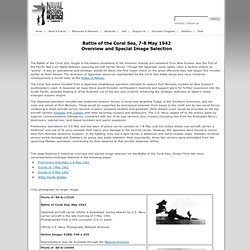

Battle of Midway. The Battle of Midway, fought over and near the tiny U.S. mid-Pacific base at Midway atoll, represents the strategic high water mark of Japan's Pacific Ocean war.

Prior to this action, Japan possessed general naval superiority over the United States and could usually choose where and when to attack. After Midway, the two opposing fleets were essentially equals, and the United States soon took the offensive. Japanese Combined Fleet commander Admiral Isoroku Yamamoto moved on Midway in an effort to draw out and destroy the U.S. Pacific Fleet's aircraft carrier striking forces, which had embarassed the Japanese Navy in the mid-April Doolittle Raid on Japan's home islands and at the Battle of Coral Sea in early May. He planned to quickly knock down Midway's defenses, follow up with an invasion of the atoll's two small islands and establish a Japanese air base there. Battle of the Coral Sea. The Battle of the Coral Sea, fought in the waters southwest of the Solomon Islands and eastward from New Guinea, was the first of the Pacific War's six fights between opposing aircraft carrier forces.

Though the Japanese could rightly claim a tactical victory on "points", it was an operational and strategic defeat for them, the first major check on the great offensive they had begun five months earlier at Pearl Harbor. The diversion of Japanese resources represented by the Coral Sea battle would also have immense consequences a month later, at the Battle of Midway. The Coral Sea action resulted from a Japanese amphibious operation intended to capture Port Moresby, located on New Guinea's southeastern coast. Attack on Pearl Harbor: Ships, Heroes and Speeches.